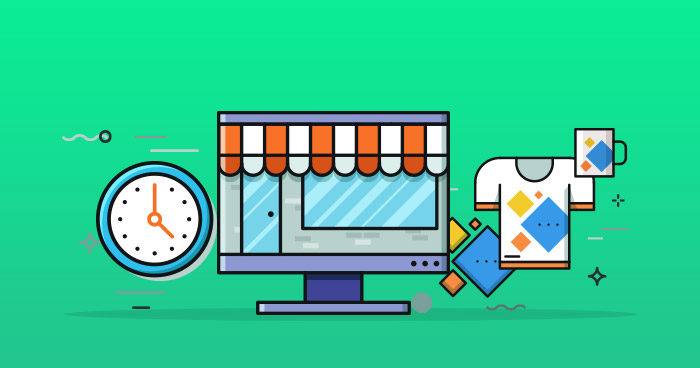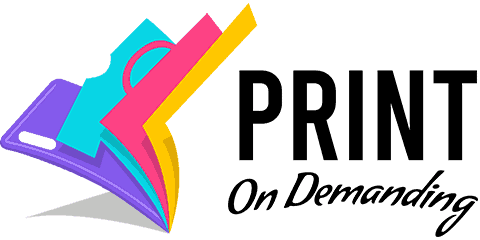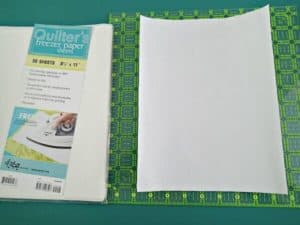Throughout this guide, we’ll cover everything you need to know to get started with dropshipping — from sourcing print on demand products to finding suppliers.
We receive reimbursement for many of the print on demand products we feature on this site, and we may feature all of them. It may impact the products we write about, where and how the product appears on a page in the future. Our evaluations, on the other hand, are uninfluenced by this. Our thoughts and opinions are entirely our own. Here’s a list of our affiliates, and here’s how we make money from them.
If you’re trying to picture out how to start a dropshipping business, you’re not alone. Today, dropshipping is used as a fulfillment method by 33 percent of eCommerce stores. With the e-commerce enterprise growing at a rate of 17 percent per year, the popularity of dropshipping is only expected to grow.
So, if you’re thinking about starting a similar type of eCommerce business, you might be wondering where to begin your search. Fortunately, we’re here to assist you.
The information in this guide will cover everything you need to know about starting a dropshipping business, including how it works, where to find print on demand products,what it is, distributors, and more.
What is dropshipping, and how does it work?
To determine how to start a dropshipping business, you must first determine whether or not this is the type of business model that is right for you. This determination must be made after a thorough understanding of what dropshipping is and how it operates is gained.
In its most basic definition, dropshipping is a type of eCommerce completion of orders that allows you to sell print on demand products on your website without being directly responsible for warehousing or shipping them yourself. As an alternative, you can purchase products in bulk from manufacturers or dropshipping suppliers, who will take care of the satisfaction process for you.
What is the procedure for dropshipping?
With this fundamental definition in mind, let’s take a closer look at how dropshipping works in practice.
Generally speaking, the dropshipping business model of eCommerce involves three parties: you, the retailer, the customer, and the supplier or manufacturer, to name a few.
To summarize the dropshipping process, the following steps should be considered.
- When an online customer purchases from your eCommerce website.
- The supplier is responsible for picking, packing, and shipping the print on demand product directly to the client.
- Your drop ship supplier receives the order information you provide.
Experts in dropshipping
So, why would you choose to learn how to start a dropshipping business over learning how to create a different type of company?
In general, dropshipping has become a well-known business model because it makes starting an eCommerce business straightforward. Increasing new products to your catalog is as simple as a few clicks, and shipping is taken care of from the beginning. Because you don’t have to pay for warehousing or warehousing, your risk is minimized. If the products you sell ever become unpopular, you can replace them with another product that does.
Furthermore, there are no upfront costs to worry about it. You only purchase items that you are confident in your ability to sell, and many drop shippers will not charge you a fee for working with them. Furthermore, drop shippers provide their vendors with shipping that is cheaper and more efficient than what they would otherwise receive. Everything else, including your eCommerce website and an internet connection, is provided free of charge.
In conclusion, most dropshipping services will allow you to create your labels, which means your customers won’t even be aware that you’re a drop shipper when they buy from you.
The disadvantages of dropshipping
Dropshipping, at this point, most likely appears to be an unattainable dream. The unfortunate reality is that many other people believed the same thing, making the dropshipping industry extremely competitive. Consequently, profit margins are low as merchants compete to offer the lowest prices on popular items due to all of the competition.
Due to low-profit margins, you must generate a large volume of business to compensate; however, you face fierce competition for every sale. This can be an extremely frustrating cycle. You are also at the compassion of the suppliers or manufacturers with whom you do business, as they have complete control over fulfillment and returns. At the same time, you are responsible for dealing with the end-user or consumer.
It can also be more challenging to establish a brand as a drop shipper, given that you are selling products from various companies.
How to dropship print on demand in 5 steps?

The final decision on whether or not dropshipping is the correct type of business for you to start is yours alone to make.
Suppose you decide to invest the time and money into finding out how to start a dropshipping business. In that case, you can make the process easier by breaking it down into smaller, more manageable steps, as we’ve done in the following section:
📦 Step 1: Work out the logistics of the situation.
Overall, the first step in starting a dropshipping business is completing the necessary paperwork and other actions required to establish a legal business entity. After completing this step, learning how to create a dropshipping business is generally comparable to learning how to start any other type of business.
As a result, when you’re starting your company, you’ll want to make sure that you do the following things:
- Choose and register your company’s name and DBA (doing business as) (if applicable).
- Obtain an employer identification number (EIN) for tax reporting.
- Settle on the type of corporate organization that best meets your requirements (sole proprietorship, LLC).
- Relying on where you conduct business and what you intend to sell, you may be required to obtain business licenses and permits from the federal, state, county, and local governments, among other entities.
Licenses for dropshipping businesses
The general operating permit that may be necessary for you to start a dropshipping business in your state, as well as several other business licenses, may be necessary if you plan to sell your print on demand products online.
Obtaining a seller’s permit is often required if you are selling print on demand products subject to taxation in your state. When it comes to seller’s access, as with most types of business licenses, whether or not it takes one and how to obtain one will differ from state to state, so you’ll want to check with your local business agency or department of commerce for more information.
Sales tax license: A sales tax license, similar to a seller’s permit, is required to charge and collect sales tax. The specific sales tax requirements and permits you must meet will be dictated by the state and city you reside in, so you should consult with local government agencies to ensure that you follow the correct procedures.
A home occupation permit is also required in some areas if you plan to operate a business out of your home, which you can find out more about here. Typically, this applies to online sellers who ship print on demand products from their homes; however, the specifics vary depending on their location. To determine whether or not a license of this type is required for your dropshipping business, you should consult with your local government agency.
📦 Step 2: Identify a market and select a niche within that market.
The next step in learning how to start a dropshipping business will be constricting down the specifics of your business idea once you have completed all of the standard tasks. Learn more about how to create a dropshipping business here.
For one thing, when it comes to dropshipping, you and your competitors have access to the same print on demand products and work with suppliers who provide similar levels of customer service. Therefore, your marketing efforts will serve as a significant differentiator between your company and your competitors. For an advertising campaign to be flourishing, you must first identify a target demographic and then sell a product that speaks to them on some level.
If you’re looking for the best dropshipping niche for your business, you can use the tips provided below to narrow your search.
What is the best way to find a niche in dropshipping?
📍 Consider what you are interested in: It’s easier to sell what you’re familiar with it. When looking for a product to sell, take into consideration your interests. It’s likely that if you enjoy something, other people will as well.
📍 Decide on a specific market segment: When you first start, you want to concentrate your efforts on a smaller subset of people so that you can tailor your business to meet their specific requirements. For example, people who practice tae kwon do, or pescatarians, are examples of niche markets. Ideally, you’ll come across a need and a product that already piques your interest.
When determining a market niche, you should conduct keyword research using Google Adwords and Trends to determine whether there is a significant amount of interest in the products you wish to sell. The greater the volume of investigations for a particular product, the greater the demand for that product.
📍 Check out what’s hot on the internet: Another way to discover products in high demand is to look through the “best selling” lists on major eCommerce marketplaces such as Amazon and eBay. You can also manage a simple Web search or use keyword tools to determine how a large number of people are searching for the product or niche you’re thinking about focusing on it.
Social media engagement: Examine what people in your niche are talking about on major social media platforms, such as Reddit, Facebook, and YouTube, to better understand their interests.
📍 Competition research: Once you believe you have identified a profitable niche market, you should investigate the competition in that market. You’ll want to look at some of the same platforms that your competitors are using to sell their products, such as Google, Amazon, eBay, and social media, among other channels, to see how they’re doing it. Ideally positioned, you’ll be able to find a niche that has some competition— indicates that buyer demand and profits to be made—but is not overly competitive. Consequently, you won’t distinguish yourself from the other sellers who are offering the same product.
📍 Evaluate profitability: Last but not least, once you have identified a market and a product, you will want to evaluate the viability of your business concept in terms of profitability. Because dropshipping margins are so low, you want to make sure you can make money in your niche before investing your time nd money. It is recommended by the dropship supplier directory SaleHoo that you sell a non-seasonal product that major brands do not dominate, is inexpensive to ship, and retails for at least $15.
Finding a niche can be amongst the most time-consuming steps in learning how to start a dropshipping business, especially when it comes to learning how to sell online. It’s critical to invest the time and effort necessary to identify the most profitable niche for your company to position it for long-term success.
📦 Step 3: Identify the most appropriate supplier
Following your decision on a specific niche to target with a particular product, the next step is to identify a supplier who sells that product in your area. Because there are so many dropship suppliers out there that offer millions of items, if you think about where to source products for dropshipping, the process shouldn’t be nearly as challenging to figure out as it is to identify a niche.
Your drop ship supplier is an essential partner in your company’s success. To identify the most appropriate supplier, we recommend prioritizing the following criteria:
📍 Expertise: You should look for a supplier who has a proven track record in the dropshipping industry and provides excellent customer service. Be sure to check out their Net Promoter Score and what people are saying about them on review websites such as TrustPilot and the Better Business Bureau before you contact them!
📍 Fees: In this day and age of razor-thin profit margins, you want a drop shipper who will not slap you with unreasonable fees. According to the company, Salehoo recommends that you should not pay more than $5 per item for stocking, packaging, and shipping. Some drop shippers will also charge you a small monthly fee to allow you to do business with them.
📍 Shipping in a short period: With dropshipping, it is expected that the product will arrive within one to two weeks (most drop shippers are located in China). If you wait any longer, you will almost certainly face backlash from your customers.
📍 Product samples: A significant occupational hazard associated with dropshipping is the presence of suppliers who sell low-quality products. Before joining into a contract with a supplier, you should request and receive samples of the products you intend to sell to evaluate their quality.
📍 Referrals: A good supplier will be happy to provide you with references to other businesses they work with if you request them. Refuses to allow, take it as a red flag, and move on.
So, now that you have any idea what to look for when searching for the best dropshipping supplier let’s look at how to find one.
The best way to locate suppliers for dropshipping
When it come up to finding a supplier for dropshipping, you have two primary options: dropship marketplaces and manufacturing facilities.
Marketplaces for dropshipping products
Dropship marketplaces are the quickest and most convenient way to get started for those new to dropshipping. These are companies that exist solely to collaborate with e-commerce drop shippers. Most offer a massive selection of thousands of different products that they purchase in bulk from manufacturers or importers and resell to vendors at a profit.
Special plugins are available from the major players in the industry to make integrating with your eCommerce website a breeze. Although we encourage you to conduct your research on dropshipping marketplaces, there are a few names to keep in mind, including:
📍 Oberlo is a free service that integrates with the Shopify shopping cart.
📍 Wholesale2B is a monthly subscription service that costs $24.99 and integrates directly with BigCommerce and Shopify.AliExpress is a free service that provides access to one of the internet’s largest drop ship product marketplaces.
📍 Dropship Direct provides a free service with over 100,000 products available. It costs $29 per month and integrates directly with the Shopify and Volusion shopping cart platforms.
As you investigate any of the suppliers listed above, or as you conduct your own Google search for other marketplaces, keep in mind the criteria we discussed earlier: the right supplier should not only offer the products you require but should also be reasonably priced and a dependable partner in your dropshipping business.
Manufacturers and importers are included.
Although dropship marketplaces make it simple for merchants to get started, it is through working with manufacturers and importers that you will generate the majority of your revenue and profits. This is because you can bypass the middleman (dropship marketplaces) and purchase wholesale directly from the manufacturer.
Manufacturers typically have minimum average order volume requirements that dropship newcomers may not be able to meet. It’s also common for them not to provide seamless integration with your eCommerce platform, which means you’ll have to do constantly of additional work when adding and managing inventory. As a result, we suggest that you wait until you have established a solid foothold in the business before selling direct source products and collaborating with manufacturing partners.
As previously stated, although working with manufacturers may be too time-consuming when you’re just getting started in your dropshipping business, you can check out the following online directories to see what they have to offer:
In the case of domestic manufacturers:
- ThomasNet
- Import Genius is a program that allows you to import data from other sources.
- Maker’s Row is a neighborhood in New York City.
For international manufacturers, the following is recommended:
- IndiaMart
- Alibaba
- Source
Finding the better provider to source your dropshipping products can take time, just as it does when identifying a market niche. As previously stated, however, because your product supplier will be such an essential component of your business, it is critical that you thoroughly research your options to find the most suitable one to support your company.
📦 Step 4: Design and develop your eCommerce website
This is the point at which we’ve identified a market and established our relationship with a supplier. We have now accomplished the first step in learning how to start a dropshipping business, creating the actual website where our products will be sold.
There are two approaches to taking on this challenge. Suppose you want to sell your products online. In that case, you can either open a store on a central eCommerce marketplace such as or eBay or build your website from the ground up using an eCommerce platform provider such as Shopify or WooCommerce. Let’s take a look at each option:
📍 Marketplaces for e-commerce products and services
The advantage of selling on well-established marketplaces such as Amazon is that they are simple to set up, and users regard them as trustworthy sources of information.
When you prefer to sell your products through an eCommerce marketplace, you will have less control over your store’s branding, design, and marketing, which will severely limit your independence as a merchant. Aside from that, these platforms will charge you a fee for each sale you make, and you will be obligated to abide by their terms of service as well.
📍 Platforms for e-commerce
Building your eCommerce website is highly recommended if you intend to be a drop shipper. As previously stated, your marketing will be what distinguishes you from your competitors, and eCommerce websites provide you with significantly more functionality in this regard than traditional websites.
There are a plethora of reputable eCommerce platform providers available. AmazonChoosing which platform to use for your business will be influenced by the dropshipping supplier you choose, as some platforms allow for direct integration with dropshipping suppliers. For example, if you’re using Oberlo, it makes a lot of sense to sell your products on Shopify.
In general, when choosing a platform, think about what kind of store you want to open. Stores that focus on products will benefit from being hosted on platforms such as Shopify or BigCommerce because they provide the extensive product functionality.
Contemplate using WooCommerce, which integrates with the content management system WordPress, if you want your store to be more content-focused (which could be beneficial to your marketing and SEO efforts).
📦 Step 5: Optimize and market your web presence
Following the creation and launch of your dropshipping website, the final step will be to do everything in your power to attract customers to your business.
As a result, no matter which platform you choose, you will need to market aggressively and optimize your website for search engines. It is already typically accomplished through a combination of email marketing, paid advertisements, and social media. Marketing Each eCommerce marketing strategy has its advantages and disadvantages. We propose narrowing your choices down to a few that work best for you.
📍 Email marketing. Plugins for email marketing tools such as MailChimp are available on most eCommerce platform providers’ websites. Collect your customers’ email addresses and send out a weekly newsletter to them, informing them of new products, sales, and content on your website.
📍 Advertisements on Facebook and Google: Facebook and Google both allow you to post advertisements for your website that will appear when people search for terms related to your business. Both provide you with the ability to reach many people while also targeting a specific niche. You can also pay a premium to ensure that your advertisements get their intended audience.Social media: Instagram,Facebook, Twitter, and other major social media platforms are excellent places to post content related to your business. This is a affordable way to market your business organically.
📍 Search engine: Search engine optimization (SEO) is the process of optimizing a website for search engines. Search engine optimization (SEO) should be the foundation of all of your marketing efforts. It is a collection of strategies used to improve your website’s ranking on search engines. There are several steps you can take to improve your eCommerce. Working with a page constructor that prioritizes SEO (such as WooCommerce), engaging in keyword research-based content marketing, and increasing the number of backlinks pointing to your website are all examples of SEO tactics.
Finding financing for a dropshipping business can be difficult.
Starting a dropshipping business is relatively inexpensive, but it is not without its expenses. At the very least, you’ll be responsible for the costs of your eCommerce website, inventory, and some shipping and marketing expenses.
There are a many ways available to you when it comes to financing your dropshipping business. The names of these are as follows:
📍 Business line of credit is a line of credit that is extended to a company. A product line of credit can be thought of as a hybrid of a loan and a credit card, as it allows you to draw on a pre-approved amount of financing while only paying concern on the amount you borrow. If you’re a drop shipper who only needs to pay for expenses as they arise, such as marketing campaigns, this is a good option.
📍 Inventory financing is a type of loan that is used to purchase inventory. You may need to obtain inventory financing to compete with dropshipping suppliers who offer low wholesale prices. Inventory financing is a type of financing in which a lender provides funds for a significant portion of catalog, and the products purchased with those funds serve as guarantee for the loan itself. Once your scheduled payments are made on time and in full, you have complete control over the inventory and can dispose of it as you see fit. However, keep in mind that if you fail to make a payment, your lender may take possession of your inventory to recover the debt.
📍 Business credit card: If you’re having trouble obtaining a loan, consider using a business credit card to supplement your income. If you are approved for a 0% intro APR business credit card, you will be able to spend money for a predetermined period without having to pay interest. Once your introductory period has expired, your annual percentage rate (APR) will begin to accrue at a rate that will fluctuate following the market Prime Rate; therefore, check the issuer’s terms and conditions for the most up-to-date APR information.
📍 Grants for eCommerce: Grants are essentially free money. However, you must typically complete a time-consuming application and wait an extended period to be considered for a grant. If you’re looking for grant possibilities, two places to start are the U.S. Department of Commerce and the Small Business Innovation Research program of the United States Small Business Administration.
It is important to note that online lenders will be your best option if you are looking for a loan. Dropshipping is a fiercely competitive industry, and banks are notoriously risk-averse institutions. Online lenders also provide quicker funding as well as greater flexibility.
Final Thoughts

It would be better if you had a good understanding of how to start a dropshipping business now that we’ve reached the end of our guide.
While it’s important to remember that the competition can be challenging, creating a highly focused concept, partnering with the right supplier and online marketplace, and investing heavily in your marketing efforts are the most efficient ways to distinguish your business from competitors.




